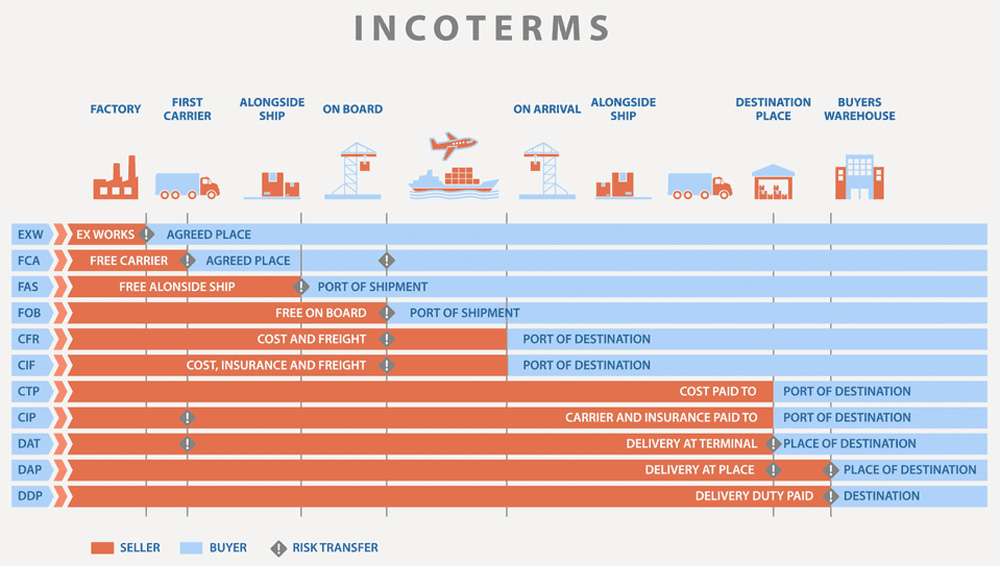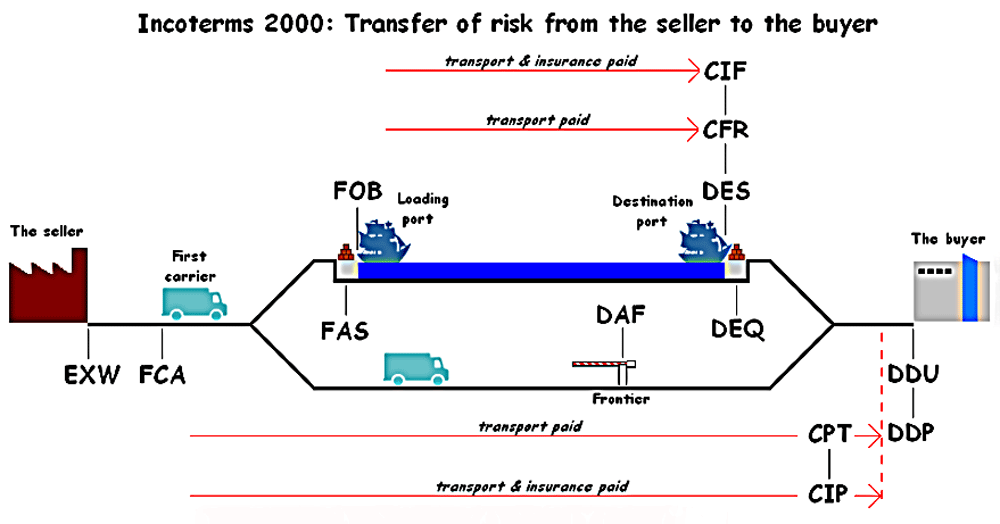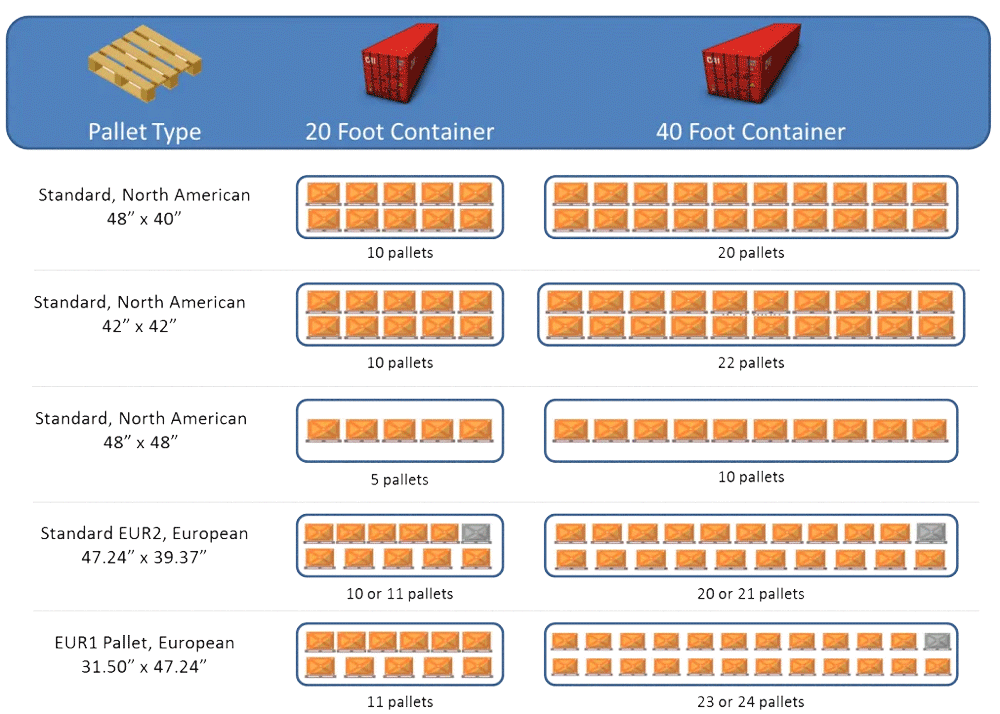What is Sea Freight?
Sea freight refers to the transportation of large-scale cargo via carrier ships. The goods are packaged in containers and loaded onto vessels. With the capacity of a typical cargo ship reaching up to 18,000 containers, shipping goods by sea is a cost-effective method for transporting large quantities over long distances.
Sea freight offers various methods of transportation for cargo:
- FCL (Full Container Load): In this method, you purchase one or more full containers to ship your goods.
- LCL (Less than Container Load): When there is not enough merchandise to fill an entire container, LCL is utilized. The contents of the container are separated once again upon reaching their destination.
- RORO (Roll On, Roll Off): In this method, goods are loaded onto a cargo ship without being removed from the truck they are transported. The vehicle drives onto the boat and drives off from one end.
- Dry Bulk Transportation involves dumping specific specialized commodities directly into the ship’s hold rather than transporting them in containers.
How does Sea Freight Work?
Sea freight is a crucial component of many businesses’ supply chain networks. Some companies utilize specialized third-party logistics (3PL) providers like NewSmartShip to ensure products’ safe and legal export. One key advantage of working with such suppliers is their expertise in meeting all the necessary criteria, eliminating the need to engage with multiple shipping firms for each item.
Once you have engaged a shipping firm, your items will be collected from your supplier and transported via the port using one of the shipping above formats. When planning delivery schedules, it is essential to consider customs clearance time on both port sides.
Opting for air freight or courier services may be more cost-effective in cases of insufficient product volume, even if LCL is available. Air freight and courier services are typically used for smaller quantities of goods, but they tend to be more expensive due to the use of smaller trucks.
Pros:
- More cost-effective compared to other methods.
- Efficient for transporting large or heavy items economically over long distances.
- Environmentally friendly with lower carbon emissions compared to other options.
Cons:
- Sea freight is known for its time-consuming nature, making it a significant disadvantage in product transportation.
- The pricing for sea freight can be prohibitively high for smaller quantities of products.
Ocean Freight Container Types
The shipping cost from China varies depending on each client’s specific requirements and services. Different rate options and services are available to cater to individual needs. Regarding sea freight, you can choose between two main options.
Full Container Load (FCL):
NewSmartShip offers weekly shipments to major ports worldwide. For FCL shipments, two types of full containers are available:
- The 20-foot container has an internal capacity of 33 cubic meters.
- The 40-foot container is capable of carrying up to 66 cubic meters.
This option ensures a secure and dependable shipping process, as your container will be sealed from departure to the final destination address.
Less than Container Load (LCL):
For lower volumes, the LCL option provides a more cost-effective solution. Only a portion of the container will transport your goods, allowing you to optimize your shipping costs significantly. Your goods will be loaded alongside shipments from other customers, and you will only be charged for the required space.
LCL is recommended for volumes ranging from 0 to 15 cubic meters, although this may vary depending on the departure port. For more information, please get in touch with us.
How long does sea freight from China take?
Shipping goods by water from China to destinations worldwide typically have the most extended transit times. However, it remains the most cost-effective option.
The following tables overview transit times from China to major ports in the United States, Europe, and Asia-Pacific.
Sea freight time from China to Europe
|
Country
|
France
|
Belgium
|
Germany
|
Netherlands
|
UK
|
Spain
|
Italy
|
Ireland
|
Romania
|
|---|---|---|---|---|---|---|---|---|---|
|
Destination Port
|
Le Havre
|
FOS
|
Antwerp
|
Hamburg
|
Rotterdam
|
Southampton
|
Felixstowe
|
Barcelona
|
Valencia
|
|
Transit Time (Days)
|
25-27
|
28-32 | 28-32 | 28-32 | 28-32 | 28-32 | 28-32 | 28-32 | 27-30 |
Ocean freight time from China to America
|
Country
|
United States
|
Canada
|
|||||
|---|---|---|---|---|---|---|---|
| Destination Port |
LA/LB
|
Oakland
|
New York
|
Miami
|
Houston
|
Toronto
|
Montreal
|
|
Transit Time (Days)
|
20-23 | 22-24 | 33-35 | 30-33 | 27-30 | 35-37 | 35-37 |
Ocean freight from China to South America
|
Country
|
Mexico
|
Guatemala
|
Columbia
|
Peru
|
Ecuador
|
||
|---|---|---|---|---|---|---|---|
| Destination Port |
Manzanillo
|
Lazaro Cardenas
|
Ensenada
|
Puerto Quetzal
|
Buenaventura
|
Callao
|
Guayaquil
|
|
Transit Time (Days)
|
37-40 |
36-38
|
38-41
|
34-36
|
33-35
|
38-39
|
45-50 |
Ocean freight time from China to Africa
|
Country
|
Nigeria
|
Nigeria
|
Ghana
|
Togo
|
Kenya
|
Tanzania
|
South Africa
|
|---|---|---|---|---|---|---|---|
| Destination Port |
Apapa
|
Tincan
|
Tema
|
Lome
|
Mombasa
|
Dar Es Salaam
|
Durban
|
|
Transit Time (Days)
|
33-35
|
33-37
|
30-35
|
32-37
|
35-39 | 38-41 | 38-41 |
Sea freight “Incoterms” in 2024
The Organization of Maritime Transport maintains strict standards. Four common “Incoterms” are used in ocean shipping from China: EXW, FOB, CFR, and CIF.
Let’s explore the responsibilities associated with each Incoterm using these examples:
- EXW, the supplier, is responsible for making the goods available and ready for dispatch at the factory. The carrier or freight forwarder then takes over the shipment from the point of goods reception outside the factory to the final delivery location.
- FOB, the supplier, is responsible for delivering the goods to the port of loading, where they are placed on the vessel. From that point, the responsibility shifts to the freight forwarder, who handles the shipment until the final delivery location.
- CIF, the carrier, assumes responsibility for freight and transport insurance up to the port of arrival.
It is crucial to have the income pro forma invoice or quotation provided. If not specified, it is essential to clarify before proceeding with any international shipment.
Note: When comparing quotations, ensure they are based on the same terms.
NewSmartShip advantage lies in offering shipping under DAP. This means we can arrange a door-to-door service, which our customers highly value. The benefits include dealing with a single point of contact throughout the delivery process, receiving an all-inclusive quotation to avoid surprises, and benefiting from continuous operational support.
The freight forwarder manages the shipping process under DAP or DDU (excluding customs duties and taxes). This Incoterm can be likened to an “Incotermdoor” service, where your shipment is entirely handled from start to finish.
Sea Freight Insurance
Knowing the risks involved in exporting products by sea and having proper insurance coverage is essential.
Shipping companies are required to have sea freight insurance. If your business ships goods by water, it is crucial to obtain commercial insurance coverage. However, purchasing insurance can sometimes be a complex process. To gain comprehensive knowledge about marine freight insurance, it is recommended to refer to a detailed guide on the subject.
There are two main types of marine freight insurance: hull and machinery (H&M) insurance and cargo insurance. These policies provide coverage for different aspects of maritime transportation.
H&M Insurance:
H&M insurance focuses on insuring the ship itself. If you operate a commercial vessel, it is typically a legal requirement to have H&M insurance. This type of coverage protects your boat in accidents such as collisions, groundings, or damage caused by adverse weather conditions or piracy.
Cargo Insurance:
Cargo insurance is highly recommended, although not legally mandated, especially when shipping valuable or perishable goods. This type of insurance provides coverage for the items being transported, offering protection against losses or damages that may occur during transit.
Sea Freight Port in China
The eastern coast of China is home to the top 8 ports in terms of traffic, spanning from Shenzhen in the south to Dalian in the north.
Guangzhou is the only one of these ports inland, at the confluence of three major Chinese rivers.
Port of ShanghaiShanghai Province UN/LOCODE: CN-SGH Container traffic in 2019: 43.3 million TEU Cargo tonnage in 2019: 514 million tons |
Port of ShenzhenGuangdong Province UN/LOCODE: CN-SNZ Container traffic in 2018: 27.7 million TEU Cargo tonnage in 2018: 194.9 million tons |
Port of Ningbo-ZhoushanZhejiang Province UN/LOCODE: CN-NBO and CN_ZOS Container traffic in 2018: 26.4 million TEU Cargo tonnage in 2018: 1.12 billion tons |
Port of GuangzhouGuangdong Province UN/LOCODE: CN-GGZ Container traffic in 2018: 21.9 million TEU Cargo tonnage in 2018: 600 million tons |
Port of Hong KongHong Kong – Special Administrative Region UN/LOCODE: HK-HKG Container traffic in 2018: 19.6 million Cargo tonnage in 2018: 258.5 million tons |
Port of QingdaoShandong Province UN/LOCODE: CN-QIN Container traffic in 2018: 18.26 million TEU Cargo tonnage in 2018: 600 million tons |
Port of DalianLiaodong Province UN/LOCODE: CN-DAL Container traffic in 2018: 9.77 million TEU Cargo tonnage in 2017: 455 million tons |
Port of TianjinTianjin Municipality UN/LOCODE: CN-TXG or CN-TSN or CN-TNJ Container traffic in 2018: 15.97 million TEU Cargo tonnage in 2018: 428.7 million tons |
Port of XiamenFujian Province UN/LOCODE: CN-XAM Container traffic in 2018: 10.7 million TEU Cargo tonnage in 2018: 218 million tons |
How many CBM of cargo can a container Load in Sea freight?
Let’s consider the example of industrial pallets measuring 100 x 120 cm.
As a reminder, each pallet weighs 30 kilograms, and the maximum load per pallet is 1.5 tons.
Based on these measurements, the following loading capacities can be achieved:
- A 20-foot container can accommodate nine pallets.
- A 40-foot container can accommodate 22 pallets.
Once you have determined the dimensions of your cartons, pallets, and container, along with their respective weights, you can make an informed decision about whether a Full Container Load (FCL) or Less-than-Container Load (LCL) is the more suitable option for your shipment.
NewSmartShip Tips: By knowing your carton size, container height (assuming an industrial pallet height of 16cm), and carton weight, you can calculate the volume and estimate the number of containers or cubic meters (CBM) required for your shipment.





